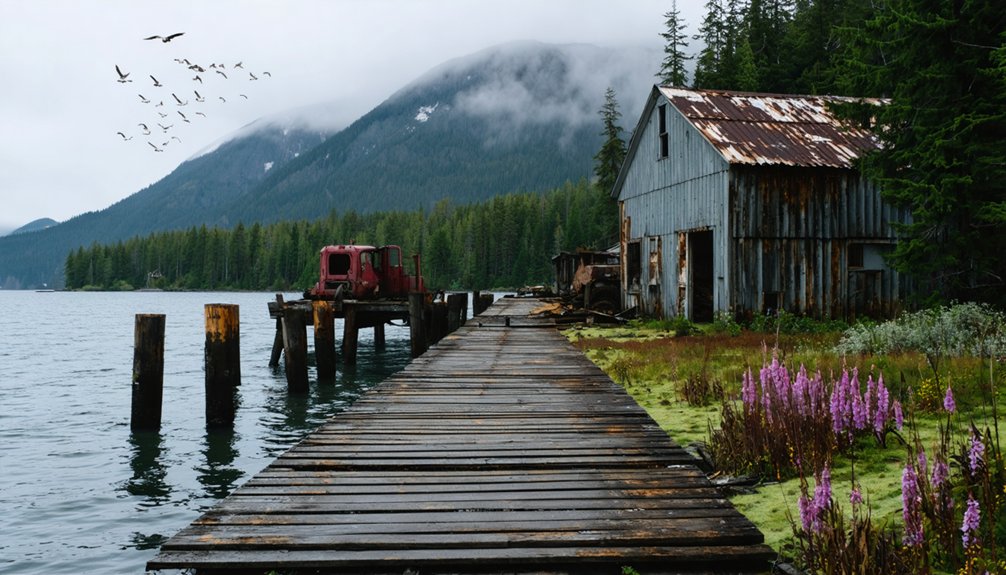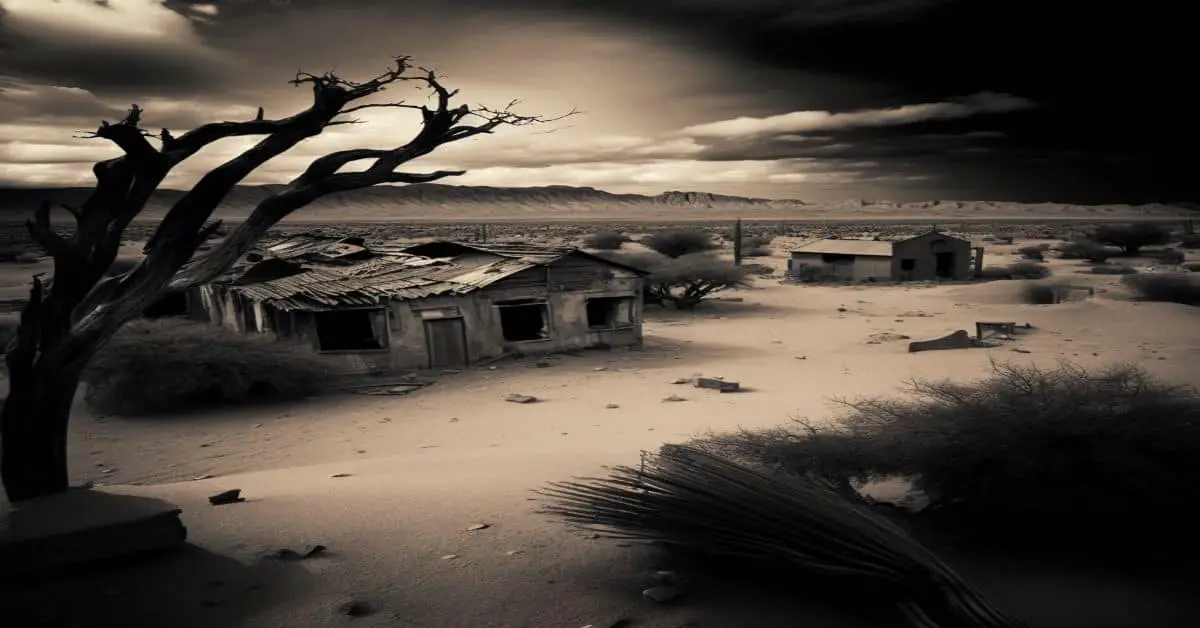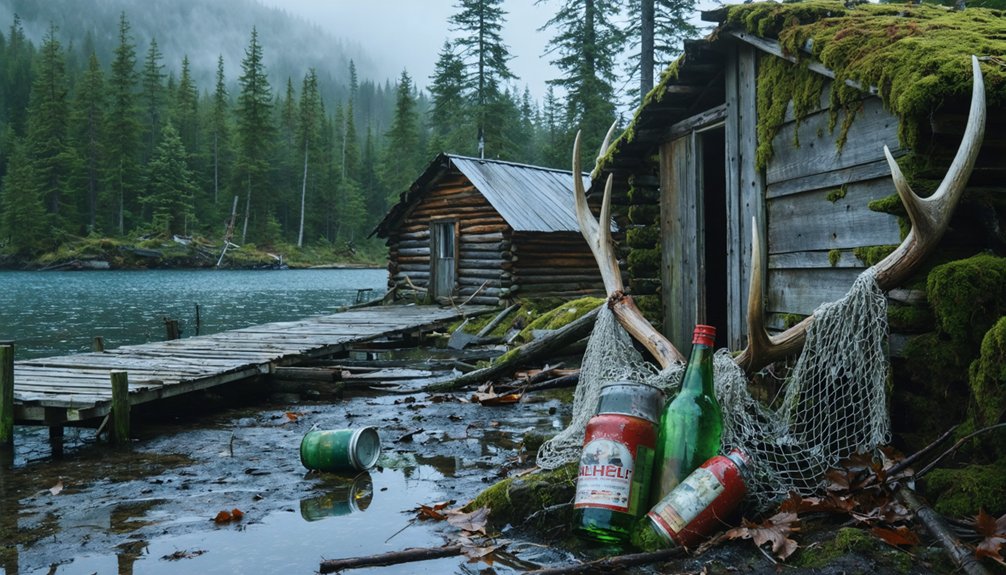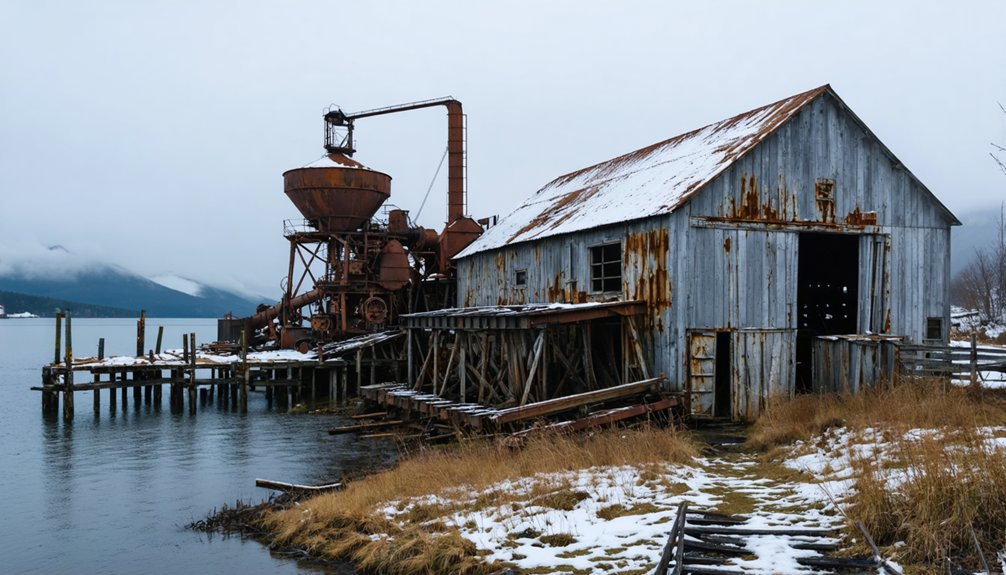You’ll find Unga, Alaska’s haunting ghost town on a remote Aleutian island, where abandoned structures tell the story of a once-prosperous mining settlement. Established in 1833 by Aleut settlers, the town flourished during the 1890s gold rush when Apollo Consolidated Mining Company extracted 150,000 ounces of gold. Today, nature slowly reclaims the remaining buildings, while a four-mile stretch of petrified forest and rich cultural heritage await those who venture to this isolated outpost.
Key Takeaways
- Unga became a ghost town after the Apollo Consolidated Mining Company ceased gold mining operations in 1922, causing population decline.
- Originally established in 1833 by Aleut settlers, Unga reached its peak during the 1890s mining boom era.
- Remaining structures from the mining period are being reclaimed by nature, including a historic narrow-gauge railroad and stamp mill.
- Access to the abandoned settlement is limited to boat or floatplane, with no developed roads or services available.
- The site features unique attractions including a four-mile petrified forest and remnants of Alaska’s early gold mining history.
The Rise and Fall of an Aleutian Settlement
While many Aleutian settlements have come and gone, Unga’s transformation from a thriving community to a ghost town exemplifies the region’s dynamic history.
The region’s powerful ocean forces and severe weather patterns shaped life on the island from its earliest days. You’ll find Unga’s roots stretch back to 1833, when Aleut settlers first established their presence on the 15-mile-long island. Originally named Delarov, the settlement flourished as Aleut culture merged with new opportunities.
The community’s golden age arrived in 1890 when the Apollo Consolidated Mining Company launched operations, bringing economic significance to the island.
But you can trace Unga’s decline to 1922, when mining operations ceased. The next decades saw a steady exodus, as families relocated to nearby Sand Point.
Life in the Remote Shumagin Islands
Beyond Unga’s ghost town lies the broader world of the Shumagin Islands, a rugged archipelago of 22 islands where life unfolds against nature’s raw elements. For detailed navigation of the area, visitors can refer to Kathy Doogan’s map.
The Shumagin Islands stand defiant against the elements, a wild collection of 22 untamed outposts in Alaska’s remote waters.
You’ll find yourself in a landscape shaped by volcanic forces, where peaks rise to 1,102 feet and the coastline twists through glacially carved bays. The region’s fishing traditions run deep, dating back to 1874 when Thomas McCollam established the first cod station on Popof Island.
Today, you can explore this wild frontier from Sand Point, home to about 1,000 residents who’ve adapted to island life. The islands were discovered and named by Captain Vitus Bering during his 1741 expedition.
Whether you’re arriving by state ferry in summer or small aircraft year-round, you’ll discover a world where storms and fog roll in frequently, and the sparse tundra vegetation reminds you of your place in this remote Aleutian outpost.
From Mining Boom to Abandoned Town
When prospectors discovered gold on Unga Island in 1881, they released a mining boom that would transform this remote Alaskan outpost.
Apollo Consolidated Mining arrived in 1890 when the island’s population was just 116 residents.
You’ll find that the Apollo Mine quickly became the region’s centerpiece, producing roughly 150,000 ounces of gold from high-grade epithermal veins. The island would continue to yield significant deposits, including the historic resource of 201,600 ounces found at the Centennial Gold Deposit.
The mining infrastructure expanded to include a narrow-gauge railroad, stamp mill, and ore cart tracks connecting the mine to Delarof Harbor.
Native Heritage and Cultural Significance
Before the gold rush transformed Unga Island, the Unangax̂ people maintained a thriving Indigenous community with deep cultural roots stretching back thousands of years.
You’ll find their cultural resilience evident in the ceremonies they held, featuring large feasts, singing, and dancing that strengthened community bonds and passed down traditional knowledge.
While Russian influences arrived in 1741, bringing Orthodox Christianity and new customs, indigenous traditions persisted.
The Unangax̂ adapted their practices under both Russian and American control, even as fur seal harvesting reshaped their economic patterns. Like their ancestors who crossed the Bering Bridge millennia ago, they demonstrated remarkable adaptability to changing circumstances.
Despite government policies that restricted their freedoms and movements, the Unangax̂ preserved their identity through their Orthodox faith and cultural practices, maintaining their connection to the land until commercial sealing ended in 1984. Similar to the Alaska Native Brotherhood, they fought to preserve their cultural heritage and combat discrimination.
Exploring the Ruins Today
Today’s adventurous visitors to Unga Island encounter a dramatically different landscape from the one the Unangax̂ people once called home.
You’ll find abandoned structures slowly being reclaimed by nature, with weathered remnants of the late 19th-century gold mining and fishing era scattered across the site. The limited hiking areas restrict exploration to roughly a quarter mile square of the island.
Similar to the 1912 earthquake that devastated Dome City’s settlements, these buildings have fallen victim to Alaska’s seismic activity and harsh weather.
To explore these ruins, you’ll need to arrive by boat or floatplane, as there are no developed roads or services.
The site offers unique geological features, including a rare four-mile stretch of petrified forest visible at low tide along the northwest shore.
Be prepared for harsh coastal conditions, including high winds, fog, and cold temperatures.
Remember to bring all necessary supplies and safety equipment, as you’re venturing into a remote location with unstable structures and limited rescue options.
Frequently Asked Questions
Are There Any Dangerous Wildlife Species Visitors Should Watch Out For?
You won’t encounter dangerous bear encounters on Unga Island. For wildlife safety, stay alert near marine mammals along shores and avoid disturbing nesting eagles or ravens during breeding season.
What Is the Best Time of Year to Visit Unga?
Like a flower in full bloom, you’ll find your best visit from mid-May to mid-September, when summer’s mild temperatures (60s-70s°F) and extended daylight hours create perfect weather conditions for exploration.
How Long Does It Typically Take to Explore the Ghost Town?
You’ll need 2-3 hours to thoroughly explore Unga’s historic structures and surroundings. While guided tours offer concise exploration, you’re free to spend more time discovering the town’s fascinating remains.
Can Visitors Legally Collect Artifacts or Souvenirs From Unga?
With over 100 years of history at stake, you can’t legally collect artifacts or souvenirs. Legal regulations strictly protect these sites, and artifact preservation requires you to only photograph or observe items.
Are There Any Emergency Services or Shelters Available on the Island?
You’ll find no permanent emergency services or shelter locations on the island. Keep emergency contacts for Unalaska/Dutch Harbor handy, as they’re your closest help in case of trouble.
References
- https://kids.kiddle.co/Unga
- https://www.explorenorth.com/library/communities/alaska/bl-Unga.htm
- https://www.miningnewsnorth.com/story/2021/04/30/northern-mining-history/forgotten-chain-of-alaska-mining-history/6797.html
- https://www.apiai.org/tribes/unga/
- https://thealaskafrontier.com/ghost-towns-in-alaska/
- https://www.tripadvisor.com/Attraction_Review-g28923-d500342-Reviews-Unga_Island-Alaska.html
- https://en.wikipedia.org/wiki/Unga
- https://www.nps.gov/aleu/upload/Lost_Villages-final-508.pdf
- https://www.apiai.org/departments/cultural-heritage-department/culture-history/history/
- https://npshistory.com/publications/alaska/aleuts.pdf



